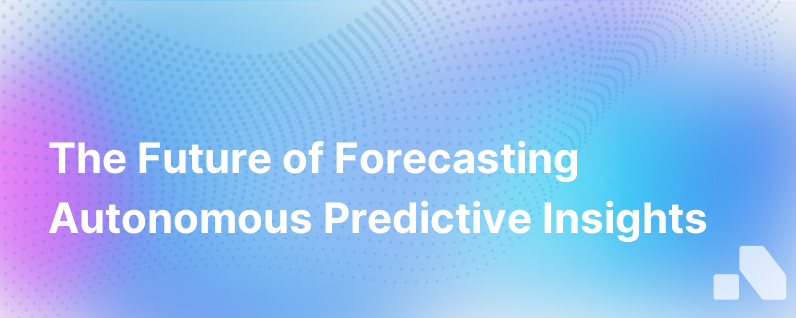
The art of forecasting is as old as business itself. From ancient merchants predicting seasonal commodity fluctuations to modern-day enterprises leveraging sophisticated data analytics, the goal has always been to peer into the future and plan accordingly. But what if forecasts had a "mind of their own," so to speak – capable of learning, adapting, and improving over time? The future of forecasting is unfolding before us, leveraging the prowess of artificial intelligence (AI) and machine learning (ML), to create forecasts that are not static but dynamic, evolving entities.
The Promising Intersection of AI and Forecasting
AI is no longer just a futuristic concept relegated to science fiction; it’s the technology of now, shaping the way we conduct business. When AI intersects with forecasting, a revolution occurs. AI-driven forecasting models can consume vast amounts of historical data, discern patterns, and predict future trends with a precision that was unthinkable a few years ago.
AI brings with it the ability to crunch numbers at an unprecedented scale, analyze variables that would overwhelm human analysts, and adjust in real-time as conditions change. An AI-powered forecast can continually update itself with new data, meaning it becomes more accurate as time goes on. This self-learning capability is foundational to what might be considered a forecast with a mind of its own.
Enhancing Decision-making with Self-Adaptive Forecasts
The primary advantage of AI-driven forecasting is its self-adaptive nature. These forecasts are not static sheets dead on arrival as soon as conditions deviate from expectations. They incorporate new information, learn from past inaccuracies, and adjust the future projections accordingly. This means that businesses can rely on forecasts that are always updated and reflective of the most current data—minimizing risks and capitalizing on emergent opportunities.
Imagine a scenario where market dynamics shift abruptly due to geopolitical events or sudden changes in consumer behavior. A traditional static forecast may render itself irrelevant overnight. However, an AI-driven forecast would detect these fluctuations early on and adjust projections, giving the business leaders a more reliable basis for decision-making.
From Predictive to Prescriptive Forecasting
As forecasts merge with AI's analytical horsepower, we move from predictive to prescriptive analytics. Predictive analytics tell us what is likely to happen, whereas prescriptive analytics suggest possible actions to benefit from predictions and also the implications of each decision.
This evolution transforms forecasting from a passive observer role to an active participant in business strategy. An AI-powered forecast doesn't just predict sales will dip in Q3; it prescribes actions—adjust inventory levels, alter marketing strategies, shift resource allocations—to mitigate the impact or leverage conditions.
Deep Learning, Big Data, and the Granularity of Tomorrow’s Forecasts
Deep learning, a subset of ML, operates like a digital neural network, mimicking the human brain’s ability to recognize patterns and categorize data. When applied to forecasting, deep learning can consider a vast range and depth of variables, from macroeconomic indicators to social media sentiment, to optimize the accuracy of its output.
These forecasts can now dissect layers, to an almost granular level, posing the ability to forecast specific segments, regions, or product lines with the same accuracy as broad-stroke business trends.
Overcoming Traditional Forecasting Challenges with AI
Traditional forecasting methods have always wrestled with certain challenges: they struggle under the weight of too many variables; they are prone to human error and bias; they become obsolete too quickly. AI sweeps these problems aside with its ability to process complex data sets, its unemotional analysis, and its perpetually self-updating nature.
Consider seasonal businesses, like agriculture or fashion retail, where success pivots on the anticipation of seasonal trends. AI forecasting can analyze decades of weather patterns, fashion trends, consumer spending data, and global supply chain fluctuations to issue highly accurate guidance—guidance that adapts with every new seasonal whisper.
The Role of Real-Time Data in Adaptive Forecasting
The key to a forecast with a mind of its own is real-time data. This kind of forecasting relies on a steady stream of up-to-the-minute information to remain relevant. IoT devices and online transactions serve as constant data sources, feeding the AI system with real-time insights.
Businesses that harness real-time data don't just react to market changes; they stay one step ahead. This kind of agility is invaluable in volatile markets where being the first to pivot can be the difference between capitalizing on a trend and falling victim to it.
Sustainability and Long-Term Planning with Intelligent Forecasts
In an era where sustainability and long-term viability are paramount, AI-enhanced forecasts provide an irreplaceable tool. They can simulate long-term scenarios, considering environmental impact, resource conservation, and the sustainability of supply chains. Companies can use these forecasts to plot a course that maximizes profitability while maintaining ethical and environmental responsibility.
Challenges and Considerations
It's not all rosy, though. The transition to AI-driven forecasting demands a significant investment in technology and skilled personnel. There's also the black-box nature of some AI algorithms, where decision paths are not transparent, potentially leading to trust issues. Companies must also be vigilant about data privacy and security when handling such large swaths of information.
Conclusion
The future of forecasting lies in intelligent systems with self-correcting, self-improving capabilities. As we move towards a world where market dynamics shift at breakneck speeds, companies armed with AI-driven forecasts will navigate the future not as passive passengers but as savvy navigators steering towards optimal outcomes. The forecast with a mind of its own isn't just a neat concept for the future; it's the necessary evolution of business intelligence.
Looking ahead, organizations like Aomni, which specialize in AI platforms for B2B sales, will become critical partners. Aomni provides real-time account research, competitive insights, and personalized sales content. It's technology like this that heralds a new era of adaptive forecasting for strategic selling and beyond.